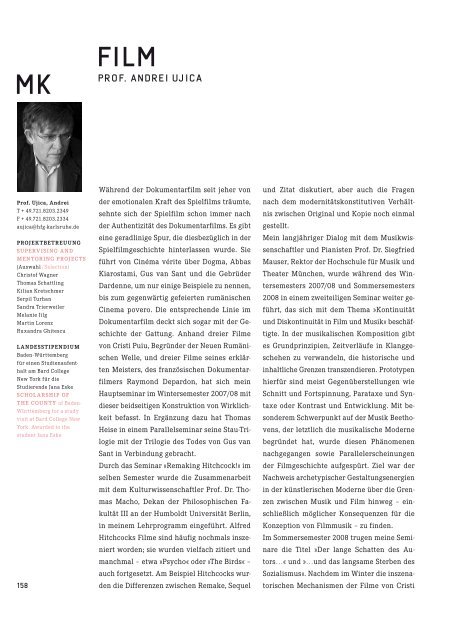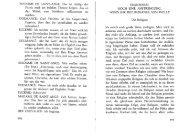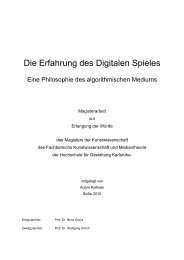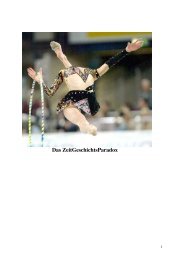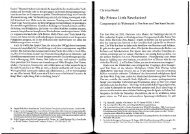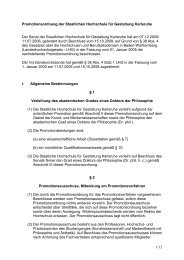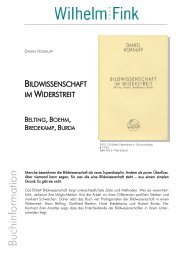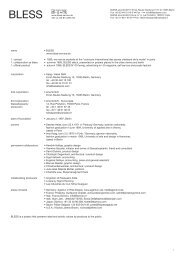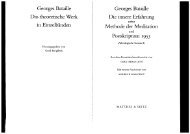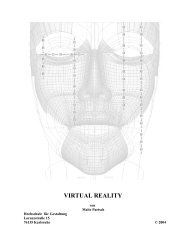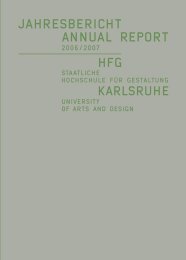jahresbericht annual report - Staatliche Hochschule für Gestaltung ...
jahresbericht annual report - Staatliche Hochschule für Gestaltung ...
jahresbericht annual report - Staatliche Hochschule für Gestaltung ...
Erfolgreiche ePaper selbst erstellen
Machen Sie aus Ihren PDF Publikationen ein blätterbares Flipbook mit unserer einzigartigen Google optimierten e-Paper Software.
M K<br />
Prof. ujica, andrei<br />
T + 49.721.8203.2349<br />
F + 49.721.8203.2334<br />
aujica@hfg-karlsruhe.de<br />
PrOjektBetreuung<br />
SuPerViSing and<br />
mentOring PrOjectS<br />
(Auswahl /Selection)<br />
Christof Wagner<br />
Thomas Schattling<br />
Kilian Kretschmer<br />
Serpil Turhan<br />
Sandra Trierweiler<br />
Melanie Jilg<br />
Martin Lorenz<br />
Ruxandra Ghitescu<br />
l andeSStiPendium<br />
Baden -Württemberg<br />
<strong>für</strong> einen Studienaufenthalt<br />
am Bard College<br />
New York <strong>für</strong> die<br />
Studierende Jana Eske<br />
ScHOl arSHiP Of<br />
tHe cOunty of Baden-<br />
Württemberg for a study<br />
visit at Bard College New<br />
York. Awarded to the<br />
student Jana Eske<br />
158<br />
FIL M<br />
P R O F. AN D R E I Uj I C A<br />
Während der Dokumentarfilm seit jeher von<br />
der emotionalen Kraft des Spielfilms träumte,<br />
sehnte sich der Spielfilm schon immer nach<br />
der Authentizität des Dokumentarfilms. Es gibt<br />
eine geradlinige Spur, die diesbezüglich in der<br />
Spielfilmgeschichte hinterlassen wurde. Sie<br />
führt von Cinéma vérite über Dogma, Abbas<br />
Kiarostami, Gus van Sant und die Gebrüder<br />
Dardenne, um nur einige Beispiele zu nennen,<br />
bis zum gegenwärtig gefeierten rumänischen<br />
Cinema povero. Die entsprechende Linie im<br />
Dokumentarfilm deckt sich sogar mit der Geschichte<br />
der Gattung. Anhand dreier Filme<br />
von Cristi Puiu, Begründer der Neuen Rumänischen<br />
Welle, und dreier Filme seines erklärten<br />
Meisters, des französischen Dokumentarfilmers<br />
Raymond Depardon, hat sich mein<br />
Hauptseminar im Wintersemester 2007/08 mit<br />
dieser beidseitigen Konstruktion von Wirklichkeit<br />
befasst. In Ergänzung dazu hat Thomas<br />
Heise in einem Parallelseminar seine Stau-Trilogie<br />
mit der Trilogie des Todes von Gus van<br />
Sant in Verbindung gebracht.<br />
Durch das Seminar »Remaking Hitchcock!« im<br />
selben Semester wurde die Zusammenarbeit<br />
mit dem Kulturwissenschaftler Prof. Dr. Thomas<br />
Macho, Dekan der Philosophischen Fakultät<br />
III an der Humboldt Universität Berlin,<br />
in meinem Lehrprogramm eingeführt. Alfred<br />
Hitchcocks Filme sind häufig nochmals inszeniert<br />
worden; sie wurden vielfach zitiert und<br />
manchmal – etwa »Psycho« oder »The Birds« –<br />
auch fortgesetzt. Am Beispiel Hitchcocks wurden<br />
die Differenzen zwischen Remake, Sequel<br />
und Zitat diskutiert, aber auch die Fragen<br />
nach dem modernitätskonstitutiven Verhältnis<br />
zwischen Original und Kopie noch einmal<br />
gestellt.<br />
Mein langjähriger Dialog mit dem Musikwissenschaftler<br />
und Pianisten Prof. Dr. Siegfried<br />
Mauser, Rektor der <strong>Hochschule</strong> <strong>für</strong> Musik und<br />
Theater München, wurde während des Wintersemesters<br />
2007/08 und Sommersemesters<br />
2008 in einem zweiteiligen Seminar weiter geführt,<br />
das sich mit dem Thema »Kontinuität<br />
und Diskontinuität in Film und Musik« beschäftigte.<br />
In der musikalischen Komposition gibt<br />
es Grundprinzipien, Zeitverläufe in Klanggeschehen<br />
zu verwandeln, die historische und<br />
inhaltliche Grenzen transzendieren. Prototypen<br />
hier<strong>für</strong> sind meist Gegenüberstellungen wie<br />
Schnitt und Fortspinnung, Parataxe und Syntaxe<br />
oder Kontrast und Entwicklung. Mit besonderem<br />
Schwerpunkt auf der Musik Beethovens,<br />
der letztlich die musikalische Moderne<br />
begründet hat, wurde diesen Phänomenen<br />
nachgegangen sowie Parallelerscheinungen<br />
der Filmgeschichte aufgespürt. Ziel war der<br />
Nachweis archetypischer <strong>Gestaltung</strong>senergien<br />
in der künstlerischen Moderne über die Grenzen<br />
zwischen Musik und Film hinweg – einschließlich<br />
möglicher Konsequenzen <strong>für</strong> die<br />
Konzeption von Filmmusik – zu finden.<br />
Im Sommersemester 2008 trugen meine Seminare<br />
die Titel »Der lange Schatten des Autors…«<br />
und »…und das langsame Sterben des<br />
Sozialismus«. Nachdem im Winter die inszenatorischen<br />
Mechanismen der Filme von Cristi<br />
FIL M<br />
P R O F. AN D R E I Uj I C A<br />
While the genre of the documentary film has always dreamt of the emotional power of feature<br />
films, the feature-film genre has always longed for the authenticity of the documentary. This<br />
runs through the history of feature film like a thread: from Cinéma vérite via Dogma, Abbas Kiarostami,<br />
Gus van Sant, and the brothers Dardenne, just to mention a few, to the currently celebrated<br />
Romanian Cinema povero. The corresponding thread running through the history of the<br />
documentary even coincides with the history of the genre. By using three films of Cristi Puiu,<br />
founder of the New Romanian Wave, as examples, and three films of his declared master, French<br />
documentary director Raymond Depardon, my advanced seminar in the winter semester 2007/08<br />
dealt with this two-sided construction of reality. Thomas Heise, in his corresponding seminar,<br />
complemented this focus by relating his “Jammed” trilogy to Gus van Sant’s Death Trilogy.<br />
With the seminar “Remaking Hitchcock!” in the same semester, I started a teaching cooperation<br />
with cultural scholar Prof. Dr. Thomas Macho, Dean of the Faculty of Arts and Humanities III at<br />
the Humboldt University in Berlin. Alfred Hitchcock’s films have frequently been remade, often<br />
been quoted, and sometimes – as with “Psycho” or “The Birds” – been followed by a sequel. By<br />
analyzing Hitchcock’s example, we discussed the differences between remakes, sequels, and<br />
quotations, and yet questions on the modernity-constituting relation between the original and<br />
the copy were also discussed once again.<br />
My years of dialog with musicologist Prof. Dr. Siegfried Mauser, Rector of the University of<br />
Music and the Performing Arts, Munich, were continued throughout the fall semester 2007/08<br />
and the summer semester 2008 in a two-part seminar focusing on “Continuity and Discontinuity<br />
in Film and Music”. In musical compositions, there are basic principles by which time variations<br />
are transformed into sounds that transcend the borders of history and content. Prototypes for<br />
this are mostly contrasts of pause and continuation, parataxis and syntaxis, or contrast and development.<br />
We examined this phenomenon and looked for parallel occurrences in the history of<br />
film, while focusing in particular on the music of Beethoven, who ultimately established musical<br />
modernity. It was our goal to find proof of the archetypical creative energies in artistic modernity<br />
across the borders of music and film – including possible consequences for the conception<br />
of film scores.<br />
In the summer semester 2008, I taught the seminars “The Long Shadow of the Author…” and “…<br />
and the Slow Death of Socialism”. Following the analysis of the directing mechanisms of Cristi Puiu’s<br />
films in the fall semester, we then concentrated on the role of the screenplay in realistic feature<br />
film by looking at the most current works of Razvan Radulescu, the other founder of the New<br />
Romanian Wave, as an example. We also once again dealt with the complex question of auctoriality<br />
in cinema. With respect to the documentary construction of reality in film, we conducted<br />
M A<br />
Prof. ujica, andrei<br />
T +49.721.8203.2349<br />
F + 49.721.8203.2334<br />
aujica@hfg-karlsruhe.de<br />
feStiValS<br />
feStiValS<br />
14.11. — 6.12.07<br />
Culturescapes: Rumänien,<br />
Basel, Bern, Uster, Zürich<br />
24. — 27.4.08<br />
Fair Play Film & Video<br />
Award, Lugano<br />
auSStellungen<br />
exHiBitiOnS<br />
22.09. — 11.11.07<br />
See Us Act, Lund<br />
Konsthall<br />
29.09. — 28.10.07<br />
Dada East? The<br />
Romanians of Cabaret<br />
Voltaire, Färgfabriken,<br />
Stockholm<br />
10.11.07 — 20.1.08<br />
In The Poem About Love<br />
You Don‘t Write The<br />
Word Love, Overgaden<br />
Institut for Samtidskunst,<br />
Kopenhagen<br />
18.01.08 — 04.05.08<br />
Archive Fever,<br />
International Center of<br />
Photography, New York<br />
06.03.08 — 02.11.08<br />
GLÜCK – WELCHES<br />
GLÜCK, Deutsches<br />
Hygiene-Museum,<br />
Dresden<br />
29.03.08 — 18.05.08<br />
Katastrophenalarm,<br />
NGBK, Berlin<br />
17.05.08 — 29.06.08<br />
Dada East? Romanian<br />
Contexts of Dadaism<br />
Zacheta, National Gallery,<br />
Warschau<br />
18.06.08 — 07.09.08<br />
Biennale of Sydney 2008,<br />
Sydney<br />
159


